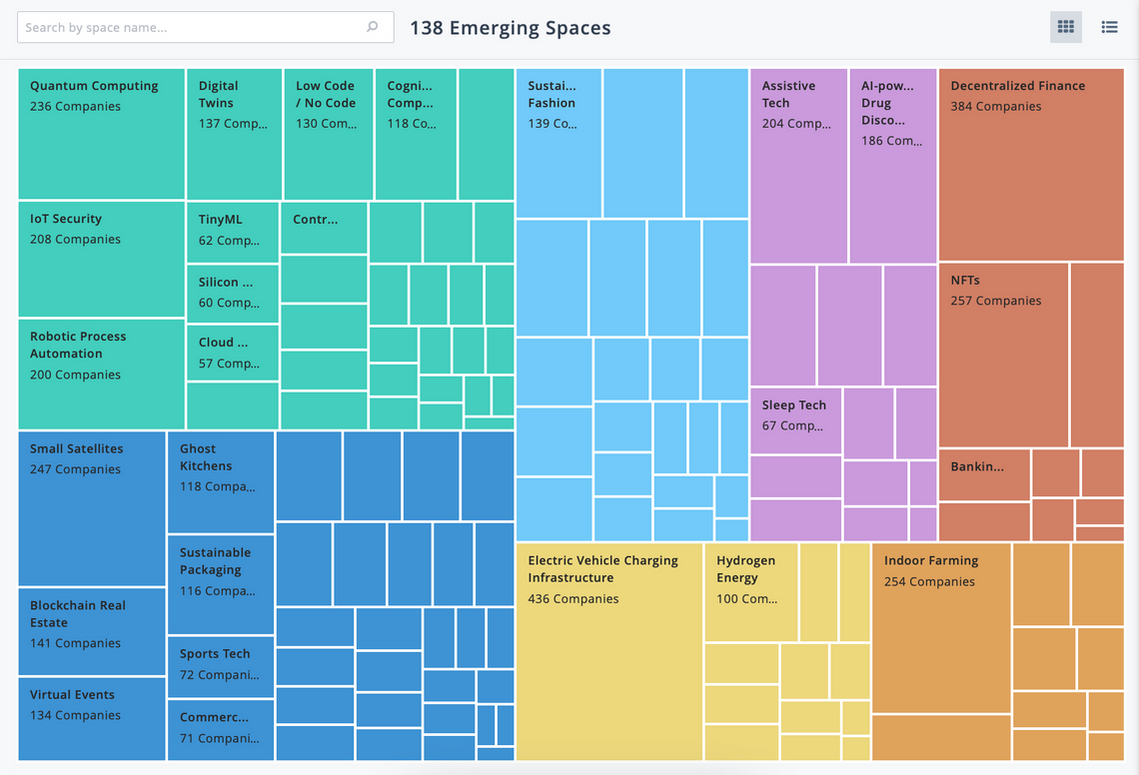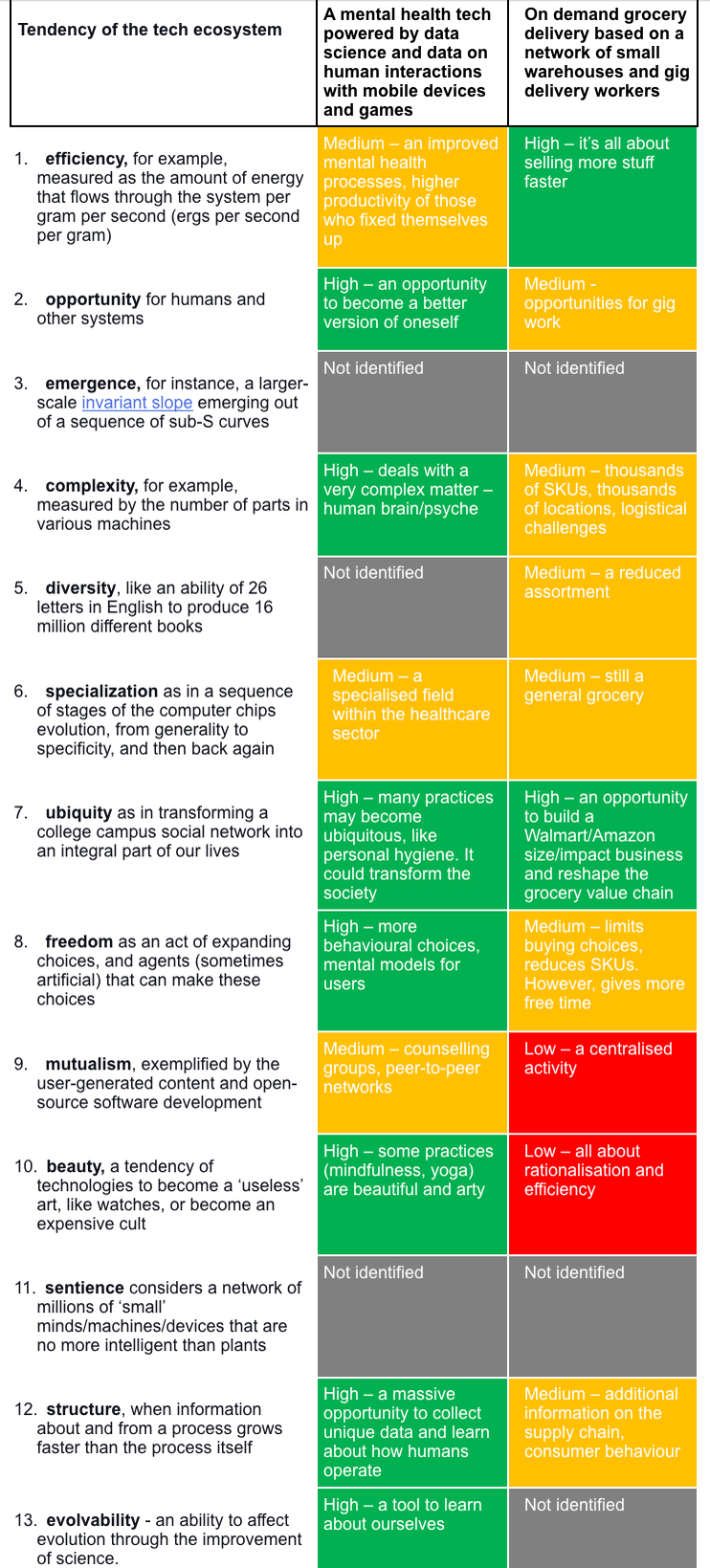How do you find the next big thing? Ask what technology wants
A framework for startup pattern-marching based on technological developments and evolution of the tech stack

Searching for the new thing right now is more challenging than ever before as the tech ecosystem expands at an unprecedented rate. This expansion is captured by investment databases. PitchBook, for example, tracks 138 emerging spaces. These spaces are split into sub-segments; deep tech, for instance, includes nine sub-categories, according to Dealroom, another database.
It’s not just expansion. The complexity of technological domains increases too. Within some themes, ‘… moving the needle even slightly… requires enormous knowledge of two very hard and disparate fields’ and the dual PhD problem emerges.
When the tech ecosystem grows in breadth and complexity, investors become flooded with information. The challenge is how to make sense out of this flood. An immediate approach might be to identify those themes that trend through frameworks like Tech Trends Index by McKinsey, Hype Cycles by Gartner, and heatmaps by CB insights. Yet, trends come and go at breakneck speed, and everything trends in one way or another. It ceases to have meaning and can’t help us choose things to focus on.
An alternative is to look at incoming data on new themes/technologies through the lens of higher-order and less shifting tendencies. The idea to rely on constants to organise the world around is not new. Jeff Bezos once noticed:
‘I almost never get the question: ‘What’s not going to change in the next ten years?’ And I submit to you that [this] question is actually the more important … - because you can build a business strategy around the things that are stable in time.’
Kevin Kelly, the founding executive editor of Wired magazine, suggests where to look for things that will not change. In his book ‘What technology wants’, Kelly explores how the tech ecosystem (‘technium’) evolved and concludes that it ‘… became so dense in feedback loops and complex interactions that it spawned a bit of independence.’ Being independent, the ecosystem gains its own desires.
Kelly goes one step further and proposes a list of thirteen desires of the tech ecosystem, urging towards increasing efficiency, opportunity, emergence, complexity, diversity, specialization, ubiquity, freedom, mutualism, beauty, sentience, structure, and evolvability. Like evolution, these desires span over humanity’s history and surpass the needs or desires of any individual or group.
According to Kelly, ’… this list of exotropic trends can serve as a sort of checklist to help us evaluate new technologies and predict their development.’ The more a particular technology expresses and extends these desires, the more inevitable it is. The hint for investors might be to focus on those technologies/themes that are likely to be inevitable.
It is not an easy task, however, to benchmark themes/technologies against these thirteen tendencies. The tendencies don’t have clear definitions. Kelly mentions that there are at least 42 theoretical definitions of complexity, for instance. The relative importance of the tendencies to each other is also not known, so calculating the ‘inevitability score’ is hardly doable. So Kelly proposes we use the approach qualitatively:
‘Using this perspective we might ask, is large-scale petrol-fed agriculture inevitable? … I would say as a rough first pass that mechanized farming was inevitable in that it increased the merits of energy efficiency, complexity, opportunities, structure, sentience, and specialization. It does not, however, support increasing diversity or beauty. According to many food experts, the problem with the current food-production system is that it is heavily dependent on monocultures (not diverse) of too few staple crops (five worldwide), which in turn require pathological degrees of intervention with drugs, pesticides, and herbicides, soil disturbance (reduced opportunities), and overreliance on cheap petro fuels for both energy and nutrients (reduced freedoms).’
My intuition is to apply Kelly’s list to emerging themes/technologies to decide which one to explore further (see an example below). Since the number of themes/technologies is growing rapidly, and my angel investing bandwidth allows me to cover a limited number only, a tool to keep discipline is required.
Another option is to apply the list to strengthen the investment thesis for a theme that was already selected. I do believe using the list with technologically complex domains makes even more sense; it puts them in a broader context and does not require deep domain expertise. For instance, thinking about database technologies through the lenses of opportunity, emergence, and mutualism expanded my view on open source software development without requiring me to become an open-source expert.
Obviously, the checklist is not a silver bullet. It’s very qualitative and subjective, and could hardly fit an investor who prioritises deployment velocity. I find it useful, however. It helps me keep discipline and provides a fresh perspective on startup land. I hope it will work out well from a financial standpoint too.
I’ll continue to apply ideas from ‘What technology wants’, explore other ways of thinking about technologies, and write about my journey.
Follow me on Twitter 🐦
***
Kudos to Andrew, Mary, and Patrick who helped me a lot with this note. If you find anything embarrassing in it, it means that I did not listen to them carefully.
***
An illustrative checklist based on Kevin Kelly’s ‘What technology wants.’

Applying Kevin Kelly’s ‘What technology wants’
Interpretation
Based on my application of Kevin Kelly’s checklist, mental health tech seems inevitable, while on-demand grocery delivery does not. The tech ecosystem, based on this checklist, will likely provide more support to a technology that leans, among other things, towards complexity, freedom, beauty, structure, and evolvability.
Output generated by the checklist expands my thinking about these two themes/technologies. To me, all user-generated data from mobile phones, wearables, and other devices will be used for healthcare purposes for decades to come. However, on-demand grocery delivery in its current form might be an intermediate step towards robotic delivery or, to the future with 3D-printed/home-lab-grown food.
NB: All above does not state that on-demand grocery delivery is a wrong investment opportunity. It just helps to navigate the opportunity space for an investor with limited resources and a long-term view.